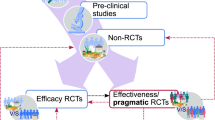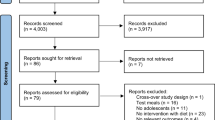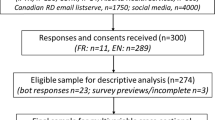Abstract
The Arbor Clinical Nutrition Updates (ACNU) is a weekly electronic nutrition journal for health professionals. Each issue summarises several recent clinical research papers appearing in the general medical and nutrition literature and which deal with a common nutrition topic. A commentary is added on how this research fits in with previous work, and what it all means for the practising clinician. ACNU is the world's most widely read electronic nutrition publication, with over 100 000 largely health-professional readers in 186 countries. It is published in nine languages and distributed by email without charge in both plain text and Acrobat formats. ACNU utilises a number of the Internet's unique characteristics to facilitate broad reach, currency and active reader feedback. This, together with its brevity and summarising format, helps to maintain its relevance to the nutrition education needs of health professionals, particularly those in clinical practice, and to overcome the factors most commonly reported by health professionals as obstacles to their greater adoption of evidence-based medicine. ACNU is intended to be a collaboration with the primary research journals to extend the reach of new nutrition research findings to a wider community of researchers, academics and clinicians than each journal might otherwise reach individually. As such, ACNU utilises the Internet to promote the goals of open-access publishing and evidence-based medicine.
This is a preview of subscription content, access via your institution
Access options
Subscribe to this journal
Receive 12 print issues and online access
$259.00 per year
only $21.58 per issue
Buy this article
- Purchase on Springer Link
- Instant access to full article PDF
Prices may be subject to local taxes which are calculated during checkout
Similar content being viewed by others
References
Arbor (2005): Arbor Clinical Nutrition Updates: Editorial Board. http://www.nutritionupdates.org/abt/abt03.html(accessed 20/1/2005).
Clickz (2005): http://clickz.com/stats/web_worldwide/(accessed 20/1/2005).
Fahamu (2002): Healthcare training and internet connectivity in Sub-Saharan Africa. http://www.tall.ox.ac.uk/globalhealthprogramme/report/Nuffieldwebreport.pdf(accessed 20/1/2005).
Feldman EB (1995): Nutrition concepts for the primary care/generalist physician. South Med. J. 88, 204–216.
Garner P, Meremikwu M, Volmink J, Xu Q & Smith H (2004): Putting evidence into practice: how middle and low income countries ‘get it together’. BMJ 329, 1036–1039.
Glanz K, Tziraki C, Albright CL & Fernandes J (1995): Nutrition assessment and counseling practices: attitudes and interests of primary care physicians. J. Gen. Intern. Med. 10, 89–92.
Hiddink GJ, Hautvast JG, van Woerkum CM, Fieren CJ & van’t Hof MA (1995): Nutrition guidance by primary-care physicians: perceived barriers and low involvement. Eur. J. Clin. Nutr. 49, 842–851.
Hiddink GJ, Hautvast JG, van Woerkum CM, Fieren CJ & van’t Hof MA (1997): Information sources and strategies of nutrition guidance used by primary care physicians. Am. J. Clin. Nutr. 65 (Suppl), 1996S–2003S.
Kelly A & Joffres MR (1990): A survey of physicians’ uses/opinions regarding nutrition education resources. J. Can. Diet. Assoc. 51, 409–412.
Kenner MM, Taylor ML, Dunn PC, Gruchow HW & Kolasa K (1999): Primary care providers need a variety of nutrition and wellness patient education materials. J. Am. Diet. Assoc. 99, 462–466.
Maiburg BH, Rethans JJ & van Ree JW (2004): GPs' needs for practice-oriented nutrition education; a Delphi study among Dutch GPs. Fam. Pract. 21, 425–428.
Mayer J & Piterman L (1999): The attitudes of Australian GPs to evidence-based medicine: a focus group study. Fam. Pract. 16, 627–632.
McColl A, Smith H, White P & Field J (1998): General practitioner's perceptions of the route to evidence based medicine: a questionnaire survey. BMJ 316, 361–365.
Mihalynuk TV, Knopp RH, Scott CS & Coombs JB (2004): Physician informational needs in providing nutritional guidance to patients. Fam. Med. 36, 722–726.
Newman CF, Downes NJ, Tseng RY, McProud LM & Newman LK (1989): Nutrition-related backgrounds and counseling practices of doctors of chiropractic. J. Am. Diet Assoc. 89, 939–943.
Peake H, Stockely M & Frost G (2001): What nutritional support literature do hospital nursing staff require? J. Hum. Nutr. Diet 14, 225–230.
Satellife (2005): http://www.satellife.org(accessed 20/1/2005).
Shai I, Shahar D & Fraser D (2001): Attitudes of physicians and medical students toward nutrition's place in patient care and education at Ben-Gurion University. Educ. Health (Abingdon) 14, 405–415.
Shaughnessy AF, Slawson DC & Bennett JH (1994): Becoming an information master: a guidebook to the medical information jungle. J. Fam. Pract. 39, 489–499.
Temple NJ (1999): Survey of nutrition knowledge of Canadian physicians. J. Am. Coll. Nutr. 18, 26–29.
Thomas DE, Kukuruzovic R, Martino B, Chauhan SS & Elliott EJ (2003): Knowledge and use of evidence-based nutrition: a survey of paediatric dietitians. J. Hum. Nutr. Diet 16, 315–322.
Touger-Decker R, Barracato JM & O'Sullivan-Maillet J (2001): Nutrition education in health professions programs: a survey of dental, physician assistant, nurse practitioner, and nurse midwifery programs. J. Am. Diet. Assoc. 101, 63–69.
Truswell AS, Hiddink GJ & Blom J (2003): Nutrition guidance by family doctors in a changing world: problems, opportunities, and future possibilities. Am. J. Clin. Nutr. 77 (Suppl), 1089S–1092S.
van Woerkum CM (1997): Media choice in nutrition education of general practitioners. Am. J. Clin. Nutr. 65 (Suppl), 2013S–2015S.
Weiss R (2004): NIH Proposes Free Access For Public to Research Data. http://www.washingtonpost.com/wp-dyn/articles/A64389-2004Sep5.html?referrer=(accessed 20/1/2005).
Acknowledgements
Curtin University (Perth, Western Australia) provides computer resources through which the publication described in this article is distributed.
Author information
Authors and Affiliations
Corresponding author
Additional information
Guarantor: AD Helman.
Contributor: AD Helman.
Discussion after Helman
Summerbell: I am interested in the interface between those people who read and those people who are publishing. I do know the editor of the Journal on Human Nutrition and Dietetics; that journal is read by every dietician in the UK. Because you get it free as part of your professional subscription. And unlike something that comes through on e-mail, you have it there and you cannot delete it as such. It is lying around and you are much more likely to read it. I also take your point about the GPs, that most of them do not read the research journals. So I wondered if in terms of creating better access to something as good as this particular publication, whether or not you could insert this publication into the hard copy of some other journals. For instance in the JHMD, we pay the dieticians to review the literature, and then that gets published in each edition of the journal.
Helman: I think it is fascinating, because people get swamped with stuff. But it is a two way thing. The advantage of hard copy journals is as you say that they are not easy to delete. The advantage of an e-mail document is that you cannot really flip through it; you have read it from top to bottom. And it does allow for greater selectivity. I think what we have going for us is a lot of credibility. We have done a lot of surveys, and unlike commercial stuff we have an extraordinarily high level of credibility. Credibility for a journal is very hard to earn and very easy to throw away. So we are very careful. I think your suggestion could work; we already do it with the East African Journal of Nutrition. We are in an active collaboration with journals such as AJCN and BJN; we could expand that collaboration.
Lodge: The question of evidence, Cochrane has been kicking around for some time. We said that evidence is one of the partners around the table now. The other partners are the needs, the priorities, and the resources. Historically, when we started looking at evidence, three corners of the table were already fixed. The needs were always pressing, priorities were fixed, resources were scarce. It was the evidence that was flopping; you did know where it was. Many of the settings that you are actually talking about, like the third world, you cannot do anything about, or even know about their needs, resources, policies and priorities. But at least you are providing that general service. Getting the evidence there is possibly as far as you can go in practical terms.
Van Woerkum: Do you include also discussions and controversies between scientists in your updates? And invitations to think about problems, to make your own mind up?
Helman: We certainly do. Quite often. We present two sides of a problem, and then come up with the conclusion that we do not really know yet, and that we need more clinical trials. What we have not yet done so far, as they do in some journals, is to ask commentaries for opposing views; this would probably be a fascinating thing to do.
Rights and permissions
About this article
Cite this article
Helman, A. Arbor Clinical Nutrition Updates: evidence-based clinical nutrition education using the Internet. Eur J Clin Nutr 59 (Suppl 1), S117–S121 (2005). https://doi.org/10.1038/sj.ejcn.1602184
Published:
Issue Date:
DOI: https://doi.org/10.1038/sj.ejcn.1602184



